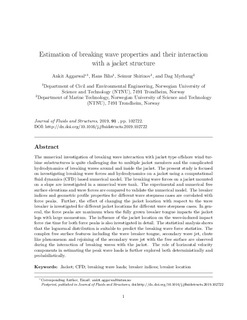| dc.contributor.author | Aggarwal, Ankit | |
| dc.contributor.author | Bihs, Hans | |
| dc.contributor.author | Shirinov, Seimur | |
| dc.contributor.author | Myrhaug, Dag | |
| dc.date.accessioned | 2020-01-27T16:53:32Z | |
| dc.date.available | 2020-01-27T16:53:32Z | |
| dc.date.created | 2019-09-13T10:20:28Z | |
| dc.date.issued | 2019 | |
| dc.identifier.citation | Journal of Fluids and Structures. 2019, 91 . | nb_NO |
| dc.identifier.issn | 0889-9746 | |
| dc.identifier.uri | http://hdl.handle.net/11250/2638171 | |
| dc.description.abstract | The numerical investigation of breaking wave interaction with jacket type offshore wind turbine substructures is quite challenging due to multiple jacket members and the complicated hydrodynamics of breaking waves around and inside the jacket. The present study is focused on investigating breaking wave forces and hydrodynamics on a jacket using a computational fluid dynamics (CFD) based numerical model. The breaking wave forces on a jacket mounted on a slope are investigated in a numerical wave tank. The experimental and numerical free surface elevations and wave forces are compared to validate the numerical model. The breaker indices and geometric profile properties for different wave steepness cases are correlated with force peaks. Further, the effect of changing the jacket location with respect to the wave breaker is investigated for different jacket locations for different wave steepness cases. In general, the force peaks are maximum when the fully grown breaker tongue impacts the jacket legs with large momentum. The influence of the jacket location on the wave-induced impact force rise time for both force peaks is also investigated in detail. The statistical analysis shows that the lognormal distribution is suitable to predict the breaking wave force statistics. The complex free surface features including the wave breaker tongue, secondary wave jet, chute like phenomenon and rejoining of the secondary wave jet with the free surface are observed during the interaction of breaking waves with the jacket. The role of horizontal velocity components in estimating the peak wave loads is further explored both deterministically and probabilistically. | nb_NO |
| dc.language.iso | eng | nb_NO |
| dc.publisher | Elsevier | nb_NO |
| dc.rights | Attribution-NonCommercial-NoDerivatives 4.0 Internasjonal | * |
| dc.rights.uri | http://creativecommons.org/licenses/by-nc-nd/4.0/deed.no | * |
| dc.title | Estimation of breaking wave properties and their interaction with a jacket structure | nb_NO |
| dc.type | Journal article | nb_NO |
| dc.type | Peer reviewed | nb_NO |
| dc.description.version | acceptedVersion | nb_NO |
| dc.source.pagenumber | 22 | nb_NO |
| dc.source.volume | 91 | nb_NO |
| dc.source.journal | Journal of Fluids and Structures | nb_NO |
| dc.identifier.doi | 10.1016/j.jfluidstructs.2019.102722 | |
| dc.identifier.cristin | 1724386 | |
| dc.description.localcode | © 2019. This is the authors’ accepted and refereed manuscript to the article. Locked until 12.9.2021 due to copyright restrictions. This manuscript version is made available under the CC-BY-NC-ND 4.0 license http://creativecommons.org/licenses/by-nc-nd/4.0/ | nb_NO |
| cristin.unitcode | 194,64,91,0 | |
| cristin.unitcode | 194,64,20,0 | |
| cristin.unitname | Institutt for bygg- og miljøteknikk | |
| cristin.unitname | Institutt for marin teknikk | |
| cristin.ispublished | true | |
| cristin.fulltext | postprint | |
| cristin.qualitycode | 1 | |

